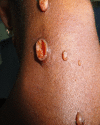Histoplasmosis in Africa: Current perspectives, knowledge gaps, and research priorities
- PMID: 35202403
- PMCID: PMC8870498
- DOI: 10.1371/journal.pntd.0010111
Histoplasmosis in Africa: Current perspectives, knowledge gaps, and research priorities
Abstract
Background: Histoplasmosis is a chronic granulomatous disease caused by the thermally dimorphic fungus Histoplasma capsulatum. The 2 variants Histoplasma capsulatum var. capsulatum (Hcc) and Histoplasma capsulatum var. duboisii (Hcd) causes infection in humans and commonly termed classical or American histoplasmosis and African histoplasmosis, respectively. Histoplasma capsulatum var. farciminosum (Hcf) affects equines. In recent times, there have been heightened sensitization on fungal infections such as histoplasmosis in Africa, aimed at improving awareness among relevant stakeholders, particularly healthcare workers. This effort is expected to be paralleled with increased detection of both classical and African histoplasmosis, which has remained underdiagnosed over the years. In this narrative review, we describe the current perspectives of histoplasmosis in Africa, identify knowledge gaps, and suggest research priorities.
Methods: A PubMed, Google Scholar, and Africa Journal Online (AJOL) literature search was conducted for studies on histoplasmosis in Africa between 2000 and 2020. Histoplasmosis essays in medical mycology textbooks were also consulted. This narrative review was prepared from the data gathered.
Findings: In the past 2 decades, histoplasmosis in general has seen a relative increase in case detection in some Africa countries, probably attributable to the gradually increasing medical mycology advocacy efforts in Africa. Histoplasmosis cases are dominated by African histoplasmosis mostly in Western and Central Africa, while classical histoplasmosis is more common in Southern and Northern Africa. Although both classical and African histoplasmosis are common in Africa, the latter is more restricted to Africa, and cases outside the continent usually have a travel history to the continent. Despite the clinical and laboratory difference between African histoplasmosis and classical histoplasmosis, it is not straightforward to distinguish them. The typical manifestation of African histoplasmosis is the appearance of lesions affecting the skin, bones, and lymph nodes and unusually linked to human immunodeficiency virus (HIV)/AIDS. By contrast, classical histoplasmosis mostly affects the lungs and is often associated with immunosuppression, mainly HIV/AIDS. The present perspectives of histoplasmosis in Africa highlight unclear details on the true burden, strain diversity, infection route and genetic basis of African histoplasmosis, availability of specie-specific diagnostic tools, and compliance with recommended antifungal therapy. These knowledge gaps represent research questions that require scientific exploration.
Conclusions: Despite a subtle increase in identifying histoplasmosis cases in Africa, it remains underdiagnosed and neglected in some parts of the continent. Increasing awareness and training among healthcare workers, bridging diagnostic and therapeutic gaps, and encouraging more research in Africa are crucial to improve the current perspectives of histoplasmosis in Africa.
Conflict of interest statement
The authors have declared that no competing interests exist.
Figures


References
-
- Darling ST. A Protozoan general infection producing pseudotuberculosis in the lungs and focal necrosis in the liver, spleen, and lymph nodes. JAMA. 1906;46:1283–5.
-
- Duncan JT. A unique form of Histoplasma. Trans R Soc Trop Med Hyg. 1947;40:364. . - PubMed
-
- Shore RN, Waltersdorff RL, Edelstein MV, Teske JH. African histoplasmosis in the United States. JAMA. 1981. Feb 20;245(7):734. - PubMed
Publication types
MeSH terms
LinkOut - more resources
Full Text Sources
Medical
Miscellaneous

